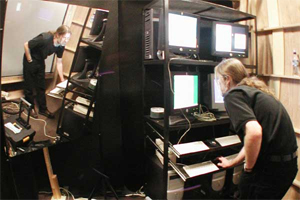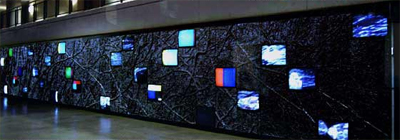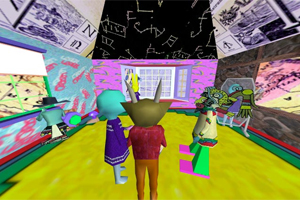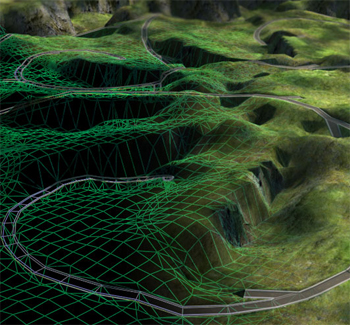Q&A with Sheldon Brown, Calit2 Artist in Residence at UCSD
By Doug Ramsey, (858) 822-5825, dramsey@ucsd.edu
San Diego, CA, April 28, 2006 -- In this question-and-answer session, Sheldon Brown, a professor in UCSD's department of visual arts, talks about art, technology, the future of online gaming, and his new role as Calit2's Artist in Residence at UCSD. To read the news release announcing Brown's new role, click here.
|
Q. What does your appointment say about Calit2's commitment to the arts?
A. When Calit2 started, it really was bold in scope. It was trying to bring together a diverse group of people, and as someone who was involved from the early stages, I wondered how Calit2 would grow given that the arts, hard sciences, engineering, and medicine all represent very disparate cultures. The appointment of an artist-in-residence underscores Calit2's belief that it can be a viable mechanism for engaging an artist to address in their art the kind of unique context that the institute is creating. It shows the continuing evolution of Calit2's desire to cultivate these different areas in a strong way.
Q. How do you see your role as Artist in Residence?
A. I want to take Calit2's ambitions, intellectual resources and facilities, and marry that wider context with my own aesthetic and thoughts on art production -- not just the content of the art, but the process of art-making in a technological world. I want to look at the unique capabilities Calit2 is bringing together, to see what they can mean for producing art.
Q. Such as?
A. Well, Calit2 has invested in a 4K super-high-resolution, digital cinema environment in its main auditorium at UCSD, which affords four times the resolution of high-definition TV. It gives you a cinematic experience that is very different because of the level of fidelity. As an artist I may have ideas about pursuing art in that framework, and because it is such a new technology, there are no methods that make it a facile piece of technology. I can bring my working methods as an artist to help craft and shape production methods for this 4K technology. So that is balancing the practice of art with the larger intellectual themes of Calit2, themes such as inventing the future of telecommunications and information techology, and how I as an artist might want to intersect with those kinds of ambitions in the context of my own work.
|
Q. Tell us about your own art. How would others define you as an artist?
A. If you ask five people, depending on what they've seen, they'll each say something different. [Laughs] The work that I do lends itself to a lot of different final forms: some of it is sculptural, some on canvas, some print. A lot is electronic images, whether related to computer games or cinematic environments or virtual reality. They are all forms I work in. But with all of them, even in sculpture, computational processes are critical. At some point there is an algorithm involved. So I do sculptures that don't plug in and don't blink, but they are very related to what I may do in developing a computer game.
Q. What about your artistic sensibility?
A. The common thread running through all of my projects is how I look at the way in which human experience is reshaped, extended, and constrained by the ongoing computerization of the world in which we live. I try to find places of tension where algorithmic structures will offer an opening up of the world around us, while giving it a new shape or new inflection that may cause anxieties at the same time. I would equate that to the process that cultures are always going through. For instance, today's technologies can be compared to the development of perspective in the Renaissance. It caused a tremendous upheaval in culture once king and man could be depicted on the same level. It changed the way people viewed the world around them. I see that happening now: we are radically changing our relationship to the world around us and ourselves by these computational methods. These changes have gains and losses; they cause anxieties, tensions and changed expectations.
|
Q. How do you balance your roles as Calit2 Artist in Residence and as Director of CRCA?
A. The directorship of CRCA is an administrative service that tries to enrich the experience of the arts community in general, and arts researchers in particular, within CRCA and Calit2. I am a facilitator trying to take care of everyone else's interests. The artist-in-residence position provides more of a space for the exploration of my own artwork.
Q. As an artist, then, what are you currently working on?
A. Whether I am making a sculpture or a multi-user virtual environment, first and foremost I am interested in perception as the interactive modality. I'm working on a project called the Scalable City and it is producing new and different outcomes as it develops. In its long arc, the Scalable City is a multi-user virtual environment that is technologically very complicated, and a lot of technology has to be developed to make it happen. It is about halfway done, and I hope to complete the bulk of the work in winter 2007. But I am also sending out parts of it in other forms, using elements from the same asset pool. There are digitally produced prints, a digital video installation, a sculptural piece, and I also hope to complete a 4K cinema piece to premiere on Calit2's amazing new system. The basic concept of the Scalable City derives from the incredibly dense databases we derive from geographic information systems (GIS), and utilizes them as seeds for online virtual experiences that use visual, aesthetic methods to engage viewers in a deeper way.
|
A. Early on I did an art residency at Arizona State University, where I became interested in computer-controlled fabrication processes. They start with a connection back to computer vision, which produces original data that I then reshape algorithmically to create the sculptural object by computer control. I am producing a series of sculptures titled Istoria which explore the intersection of the virtual and physical worlds. They are produced with a variety of computer-control methods and will go up a few notches as we develop a computer-controlled fabrication facility here at Calit2.
Q. You have pioneered an Experimental Game Lab within Calit2. How will games of the future differ from today's generation of games?
A. Tomorrow's games will go beyond what usually passes for interactivity in virtual spaces, such as competition and goal orientation. I find the computer game and virtual space an incredible extension of a vision. From the very beginning, computer and video games have been characterized by what I call a 'twitchiness' of vision designed to call attention away from rudimentary graphics and slow rendering. But today we are developing rendering technologies that can produce real-time images that are very lush, very dense, very rich and very realistic. That greater fidelity may allow us to get away from the twitchy aesthetic of Pac-Man or even Tomb Raider. More powerful computing platforms and better rendering techniques over the next few years will radically shift the temporal nature of games, which will no longer only be about immediate reaction time, as they are right now.
Related Links
Sheldon Brown Website
Center for Research in Computing and the Arts
Related Articles
Technology Institute at UC San Diego Names First Artist in Residence





